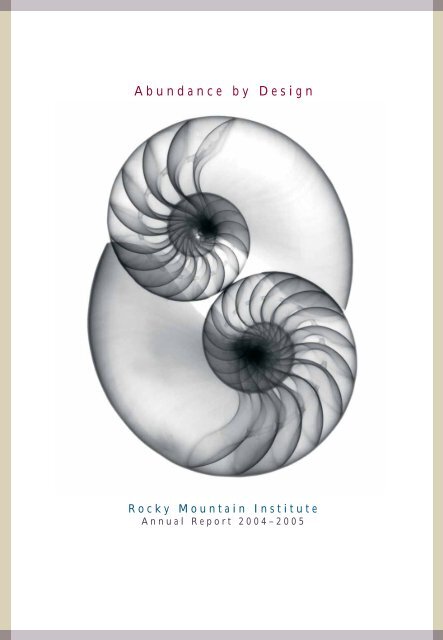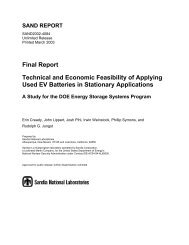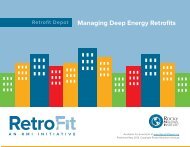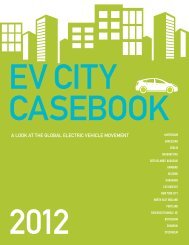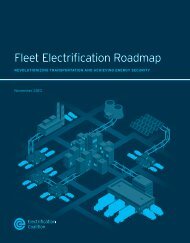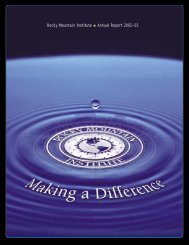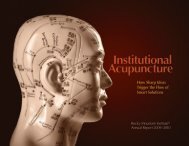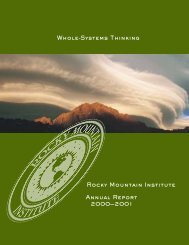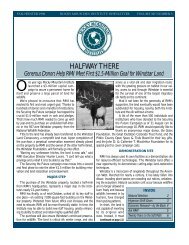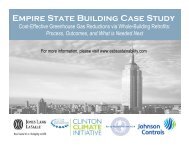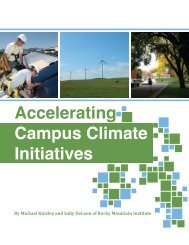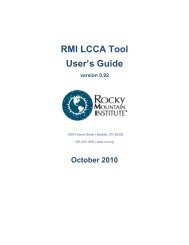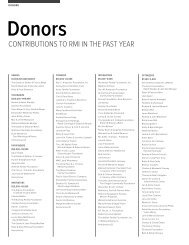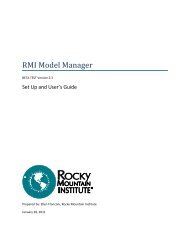Abundance by Design - Rocky Mountain Institute
Abundance by Design - Rocky Mountain Institute
Abundance by Design - Rocky Mountain Institute
- No tags were found...
Create successful ePaper yourself
Turn your PDF publications into a flip-book with our unique Google optimized e-Paper software.
<strong>Abundance</strong> <strong>by</strong> <strong>Design</strong><strong>Rocky</strong> <strong>Mountain</strong> <strong>Institute</strong>Annual Report 2004–2005
From the Co-founder and CEO<strong>Abundance</strong> <strong>by</strong> <strong>Design</strong>IN AUGUST 2004, WHILEhelping visionary developerTatsuo Akimura articulatethemes for his Kobunaki ecovillagenear Osaka, I thought ofa phrase—“abundance <strong>by</strong>design”—that encapsulates notjust his project but what we doat <strong>Rocky</strong> <strong>Mountain</strong> <strong>Institute</strong>.<strong>Abundance</strong> is the opposite of scarcity. It substitutessufficiency for privation, contentment for envy, tranquilityfor conflict, synergy for tradeoff. Just as wastespawns scarcity, elegant frugality fosters abundance.RMI creates abundance <strong>by</strong> wringing far more benefitfrom energy, water, materials, and other resources, andshowing people how to do more and better with lessfor longer. We reveal how to meet the needs of asecure, just, prosperous, and life-sustaining world not<strong>by</strong> felling the last tree and catching the last fish, not <strong>by</strong>scraping the bottom of the barrel from the ends of theearth, but <strong>by</strong> innovative design, rigorously applied andvigorously promoted.<strong>Design</strong> is the alchemy of purpose into artifact. Ittranslates intention into action. Bad, dis-integrateddesign causes many of the world’s problems, boostingcost, complexity, and inefficiency. RMI aims to makebad design unmarketable. In buildings, vehicles, andvery diverse sectors of industry, redesigning roughly$20 billion worth of facilities in recent years, RMI optimizeswhole systems for multiple benefits and “tunnelsthrough the cost barrier,” turning diminishing intoexpanding returns. Often such holistic designs areinspired <strong>by</strong> “biomimicry” (p. 10).Efficient and restorative use of resources is part ofRMI’s broader vision of “natural capitalism”(www.natcap.org). Natural capitalists also manufacturethe way nature does, with closed loops, no waste, andno toxicity; adopt business models that reward theseshifts; and reinvest profits into natural and human capital.RMI’s practice integrates all these elements into anew way of doing business that’s alluringly profitable—largely because efficiency costs less than the resources itsaves. This turns seeming burdens like oil-independenceand climate protection into keys to wealth and competitiveadvantage. To quote Martin Melaver (a Georgiagreen developer), the buck starts here.©Judy HillRMI’s ju – jitsu spreads “abundance <strong>by</strong> design” <strong>by</strong>redirecting the unmindful market forces that drivewealth-destroying depletion, destruction, and pollution.Our experts help early private-sector adopters ofnatural capitalism, especially of radical energy andresource efficiency, achieve conspicuous success sotheir rivals must follow suit or lose share. This competitionimplements and refines concepts while earningconsulting revenues that cover most of the <strong>Institute</strong>’scosts. Such “applied research” simultaneously carriesout our mission, funds research, leverages grants anddonations, and creates rapid learning, immediatepractical application, teachable cases, credibility, andeffectiveness. In collaboration with many partners, it’sstarting to make “abundance <strong>by</strong> design” the engine ofthe next industrial revolution.Our latest and largest application is Winning the OilEndgame (www.oilendgame.com). This independent,peer-reviewed synthesis demanded extraordinary commitment,effort, and sacrifice, and the five primaryresearcher/authors drew on the skills and time of everyonein the <strong>Institute</strong>. But it was worthwhile and timely.Our study presented the first solution that makes senseand makes money—a detailed roadmap for eliminatingU.S. oil use, more cheaply than buying oil at half today’sprice. Now we’re starting a three-year, nearly $4-millioneffort—the most ambitious we’ve ever undertaken—toturn these findings into reality (pp. 4–5).That’s part of a disciplined <strong>Institute</strong>-wide effort togo beyond merely articulating clear, practical, profitablesolutions. More and more, we’ll make themactually happen, with accountability, feedback, rapidlearning, and wide outreach-<strong>by</strong>-example. The fiscalyear from mid-2004 to mid-2005, reported herein,has brought encouraging progress toward deeper andwider implementation, which our new strategic planwill intensify. In short, we’re designing and executingnew ways to make our ideas self-evident, ubiquitous,and…well, abundant.To all our companions and supporters in this journey,and to the Trustees and colleagues who carry itsburdens, I am deeply grateful.AMORY B. LOVINS2
From the Executive DirectorRMI’s Bridge Construction: People at WorkIN LAST YEAR’S ANNUALreport, I described our effortsin “building a bridge to RMI’sfuture” based on findings fromour planning sessions withadvisors, Trustees, friends, andcolleagues. In mid-July 2005,we finalized a business planfor RMI’s Research &Consulting division that incorporated and expandedupon those findings. The plan lays out stages for thesolid and permanent construction of the bridge thatensures RMI’s future viability and effectiveness.With approval of the business plan <strong>by</strong> our Board,we have commenced bridge construction with seriousand immediate capacity-building for our Research &Consulting (“R&C”) group. First, we promoted Dr.Joel Swisher, PE from leadership of the Energy &Resources Team to the position of R&C ManagingDirector. Former Managing Director Kyle Datta hasbeen named R&C Senior Director and works acrossall teams with project and business development.From August 2005, long-time friend and colleagueGreg Franta, FAIA leads our RMI/ENSAR BuiltEnvironment Team, which includes several staff membersfrom Greg’s firm ENSAR. This new name for ourformer Green Development Services group reflects significantnew skill sets that increase the depth andbreadth of RMI’s ability to tackle a variety of opportunitiesin the built environment.In September 2005, we also welcomed two seniorpractitioners: John Anderson, PE, our new Energy &Resources Team leader, and John Waters, our newIntegrative <strong>Design</strong> Team leader. John Anderson bringsmore than twenty-five years’ experience in the energysector—including a successful career with theNational Renewable Energy Laboratory and its predecessor,the Solar Energy Research <strong>Institute</strong> (SERI)—toRMI’s work in energy resource investment strategies,carbon management, and distributed resource programdesign and evaluation. Engineer John Watersbrings more than twenty years’ experience in productdevelopment and manufacturing at GeneralMotors and Delphi. His experience will complementthe skills of our Integrative <strong>Design</strong> Team members asthey develop RMI’s methodology in whole-systemdesign and apply it across resource-intensive industries,primarily at the manufacturing and facilitylevel. With this senior leadership in place, we willcontinue to build an excellent line-up of projectmanagers and to support rising stars within theseteams that take our work into the world.One of the reasons RMI has had such an earlysuccess in capacity-building is the work of our firstprofessional human resources director. We are seriousabout retaining and supporting the remarkablestaff RMI has been able to attract. Dr. DavidRothstein, our new HR Director, is therefore improvingour personnel policies and professional developmentgoals and strengthening all the foundations oforganizational maturation and growth.This gratifying increase in capacity comes at anopportune time in the life of the <strong>Institute</strong>, as it steadfastlyproceeds to implement one of its most importantpieces of work—Winning the Oil Endgame, (pp.4–5). We are committed to this bold and timelyproject that blends so closely with our other work,both strategically and substantively. With the newhands and minds buttressing RMI’s already ableResearch & Consulting group, we look forward tothe coming year. Certainly, we will have the strengthto meet the challenge of our mission.MARTHA C. PICKETT<strong>Rocky</strong> <strong>Mountain</strong> <strong>Institute</strong> Annual Report: 2004–053
Winning the Oil EndgameIN 2002–03, ROCKY MOUNTAIN INSTITUTEsaw the “avoidable oil crisis” we’d been warningabout for decades becoming imminent, so welaunched a detailed effort to discover how much U.S.oil use could be profitably saved or displaced. Theanswer: all, cheaper than buying oil for $26 per barrel(the U.S. government’s 2004 forecast of world oilprice in 2025, all in year-2000 $).In 1850, whaling was one of America’s largestindustries, and whale-oil lamps lit most homes.But as whales became shy and scarce, whale oilprices elicited competitors that grabbed more thanfive-sixths of that lighting market in the nine yearsbefore Drake struck oil in 1859. The inattentivewhalers were astounded.Oil is now poisedto repeat that history.A nearly two-yearand million-dollar effort<strong>by</strong> five RMI coauthors,scores of staff, and hundredsof peer reviewersand advisors showedhow. On 20 September2004, RMI publishedits oil solution: an independent,comprehensive319-page study ofhow to get the U.S. completelyoff oil and revitalizethe economy, led <strong>by</strong> business for profit.By the 2040s, we found, the U.S. could redoubleits efficiency of using oil (already doubled since1975) at an average cost of $12 per saved barrel.At an average cost of $18 per barrel, saved naturalgas and advanced biofuels (mainly ethanol madefrom woody, weedy plants like switchgrass andpoplar) could replace the rest. The best technologiesin or entering commercial service in 2004could profitably triple the efficiency and improvethe safety of cars, trucks, and planes, with all thesize and performance officially projected for 2025.The transition would require a $180-billion investment—halfto retool the car, truck, and plane industries,half to build an advanced biofuels industry.Returns <strong>by</strong> 2025: $155 billion annual gross savings,$70 billion annual net savings, a million new jobs, amillion existing jobs saved, 26 percent lower carbondioxide emissions, and a safer world, all driven <strong>by</strong>business logic. Aligning public policy would make thetransition faster, smoother, and less risky—withoutfuel taxes, subsidies, mandates, or new federal laws.A year ago, we launched Winning the Oil Endgameat the National Press Club, Resources for the Future,the National Defense University, the Center forStrategic and International Studies, and the Councilon Foreign Relations (whose Energy Security Groupchairman called it “one of the most important energystudies in decades”). So what’s happened? More than150,000 people have visited www.oilendgame.com;many have downloaded the book gratis. Web postingof all sources and spreadsheets forestalled analyticalchallenges. The study’s apolitical content and tone,eloquent forewords <strong>by</strong> George Shultz and formerShell Chairman Sir Mark Moody-Stuart, and cosponsorship<strong>by</strong> the Office of the Secretary of Defense andthe Chief of Naval Research all broadened credibility.Winning the Oil Endgame was featured in the WallStreet Journal (<strong>by</strong> President Reagan’s National SecurityAdvisor, Robert C. McFarlane), Fortune, Time (“one ofthe best analyses of energy policy yet produced”),Newsweek International, BusinessWeek Online, RiponForum, and Worth; favorably covered <strong>by</strong> theEconomist, New York Times, Los Angeles Times, DailyTelegraph, Foreign Affairs, MSN Money, and others;and presented to more than forty important industry,policy, and scientific conferences. There’s growingpolitical interest at national, state, and internationallevels. And the message is resonating strongly with itsintended audiences—business and military leaders.Since launch, problems in both the Persian Gulf andthe Gulf of Mexico have boosted oil prices and heightenedthe need for dramatic technological and policyinnovation. Most Americans realize that a country thatuses 25 percent of the world’s oil, produces 9 percent,and owns 2 percent can’t drill its way out. Now comesthe hard part: playing the oil endgame to win.Our proposed policies are novel, light-handed, andmarket-oriented. For example, at our suggestion, theDistrict of Columbia has adopted the functional equivalentof a “feebate”—making efficient vehicles cheaperand inefficient ones costlier (best done in each sizeclass), so buyers consider lifecycle fuel savings, not justthe first 2–3 years’ worth. This illustrates how statescan innovate without federal leadership or hindrance.But the main leadership will come from business.At mid-2005, RMI’s “off-oil” team was refining athree-year, $4-million plan to tweak precise4
“trimtabs” in heavy trucks, military procurementand R&D, automaking, fuels (oil, gas, and biofuels),and finance, to head the U.S. irreversibly off oil.This effort has shown promise even from its firstweeks. In heavy trucks, for example, RMI is creatingdemand for tripled-efficiency models <strong>by</strong> facilitatingconversations between major fleet operators andtheir suppliers. The prize is a 60 percent InternalRate of Return and doubled margins for a typical bighauler—but until we told them, the customers didn’tknow how. More know now (others will soon),and they’re very attentive.Meanwhile, there’s encouraging interest in thePentagon. A respected military think-tank reviewingour study concluded: “[A]ggressively developing andapplying energy-saving technologies to military applicationswould potentially do more to solve the mostpressing long-term challenges facing DoD and ournational security than any other single investmentarea.” But the win can be even greater. Just as DoD’sR&D created the Internet, GPS, jet engines, andmicrochips, it could speed advanced materials, transformthe car, truck, and plane industries, and lead thecountry off oil altogether so DoD needn’t fight over it.After mid-2005, progress accelerated further. InAugust, the National Highway Traffic SafetyAdministration tentatively adopted our recommendationto base future light-truck efficiency standards onsize, not weight, thus encouraging advanced materialsthat decouple the two so big cars become light butsafer. By September, a Wall Street Journal news story,Financial Times editorial, and majorautomakers had concurred on lightweightsafety, while our senior discussionsintensified in Detroit on how newmaterials (see below) can save oil, lives,and money. Our invited testimonybefore 11 members of the SenateCommerce Committee helped broadentheir vision. And in October, we coorganizeda New York conference to engage WallStreet with new investment opportunities.Three years hence, we hope to report that oil hasbegun its inexorable, decades-long, market-drivenjourney to emulating the obsolescence of whale oil—to the benefit, we predict, even of oil companies.RMI’s Automotive InnovationIn 1991, cofounder Amory Lovins invented the Hypercar ® concept—ultralight, hybrid-electric, ultra-low-drag vehicles withhighly integrated, radically simplified, software-rich design—and in 1993, put the concept in the public domain so nobodycould patent it. The resulting competition leveraged RMI’s $3-million R&D investment <strong>by</strong> roughly 3,000-fold, helping to stimulatetoday’s hybrid-electric vehicles.In 1995–96, RMI’s Hypercar Center assessed potential volume production, and in 1998, with 17 industrial partners, commissioneda Lotus Engineering feasibility study that spawned RMI’s fourth for-profit spinoff—an automotive engineering firm.The spinoff team and a leading European automotive engineering firm designed a quintupled-efficiency carbon-fiber midsizeSUV concept car, production-costed and competitively manufacturable.* When niche production hopes were dashed <strong>by</strong>the late-2000 collapse of the technology capital market, the team persevered, and the work took a new twist.By 2002, automakers familiar with the SUV design were eager to make carbon-fiber ultralight cars, but lacked an affordablemanufacturing process. In mid-2003, led <strong>by</strong> former Hypercar Center engineers Dr. Jon Fox-Rubin and Dave Cramer, theteam opened an engineering development center in Glenwood Springs, Colo.Their innovative manufacturing process, whose umbrella patent issued in August2003, quickly emerged as a promising candidate to bring RMI’s automotive conceptto market, perhaps as early as 2010.Soon the spinoff was doing business as Fiberforge ® (www.fiberforge.com), commercializing its process for making costcompetitivethermoplastic advanced-composite structures. By mid-2005, this small firm was widely considered a leader inNorth America. Fiberforge’s process can halve a vehicle’s weight and fuel use, at no extra cost (because simpler automakingand smaller propulsion system pay for the costlier materials), and with improved safety (because such composites canabsorb up to 12 times as much crash energy per pound as steel). Fiberforge won a World Technology Award in 2003, as RMI’sauto concept had done in 1999.Fiberforge is selling samples, prototype parts, and development services to automakers and Tier One automotive suppliers,among others. Financed <strong>by</strong> private “angel” investors, foundations, and an RMI capital loan, it’s growing rapidly towardprofitability. Its success would offer automakers and suppliers worldwide the key missing technology to fulfill RMI’s 1991vision of the biggest automotive gamechanger since Henry Ford’s Model T— equivalent in U.S. oil savings to discovering aSaudi Arabia under Detroit.* www.rmi.org/sitepages/pid175.php#T04-01<strong>Rocky</strong> <strong>Mountain</strong> <strong>Institute</strong> Annual Report: 2004–055
RMI Energy & Resources TeamLooking Forward to Carbon Limits?JUST TWENTY YEARS AGO, THE NOTION OFtrimming greenhouse gas (GHG) emissions, notablycarbon dioxide, was barely on a typical utility’s radarscreen. And if it was, it was generally a <strong>by</strong>product ofcalls to trim pollution and the acid rain, visual blight,and asthma that came from burning coal. In the mid-1980s, many utilities installed flue gas desulfurizationunits (a.k.a. “scrubbers”) and soot-capturing filters,then went back to business as usual. Global climatechange seemed to most an academic speculation.How things change. Today, every forward-thinkingutility is acutely aware that the electricity industry’semission of 39 percent of U.S. carbon dioxide is itssingle most important environmental challenge—andcarries a heavy price tag as fuel costs rise. With powergenerators a crucial part of the global fight to trimemissions, RMI’s broad energy expertise and engagementhave lately refocused on more climate-safe,clean, resilient, and cost-effective ways to provideelectrical services.Today’s increased awareness of climate change coincideswith the flowering of parallel revolutions in technology,business models, and public policy that RMIhas been helping for decades to create. Utilities todayenjoy a broad suite of creative and attractive newoptions: generating electricity moreefficiently, generating it at the rightplace and scale (distributed generation),using it more productively(end-use efficiency), balancing thepeaks and valleys of consumption(demand response), “firming” wind- and solar powerso they’re available when needed, estimating inventoriesand investing in reductions of greenhouse gasemissions, and even educating forward-thinking financiersand customers about emerging carbon taxes andtrading regimes.These days, RMI’s Energy & Resources Teamdraws on its longstanding thought leadership in theseareas to help utilities plan and manage energy supplyanddemand-side resources, and to understand thenew constraints and opportunities of greenhouse gaslimitations. During the past year, much of our energywork—complementing related “off-oil” work (pp.4–5)—applied cutting-edge thinking to utilities’unique challenges. This work has relied on researchand implementation grants from the Hewlett andLuce Foundations, as well as on consultancies forutility clients. With Hewlett and other foundationsupport, we have also developed important new intellectualcapital, including, in June 2005, the first compilationof the actual size and speed of deployingdecentralized low- and no-carbon power sourcesworldwide. (Surprisingly, they turned out to be biggerand far faster-growing than nuclear power.) We alsocompleted much of an in-depth assessment of the latestdemand- and supply-side opportunities in naturalgas; made RMI’s operations carbon-neutralthrough efficiency and trading (as an AssociateMember of the Chicago Climate Exchange);and advised some major energy users, such asthe Stanford Linear Accelerator Center, oncutting their energy costs and GHG emissions.Those emissions will long remain a majorglobal challenge, but RMI’s innovative strategiesand technologies are already showing newpaths to practical, advantageous solutions forutilities and other major energy firms.During mid-2004 to mid-2005, highlights of theEnergy & Resources Team’s work included:• Assisting the implementation of Energy ResourcePortfolio Planning for the City of Palo Alto Utilities.RMI’s ongoing role in the CPAU planning processinvolves reviewing the current electric resource plan,designing economic criteria for efficiency programs,prioritizing efficiency program strategies, evaluatingthe potential for local energy resource options, and6
helping to integrate supply and demandsideoptions into risk-managed, least-cost portfolios.The local resource evaluation includesdetailed modeling and economic analysis of thepotential for distributed tri-generation of cooling,heat and power at specific large customer sites.• Helping Great Plains Energy develop the businesscase for demand response and distributed generationprograms with commercial and residential customersof Kansas City Power & LightCompany. RMI evaluated the available technologiesand available products, reviewed a rangeof proposed program designs, prioritized the programsin terms or potential impact, and analyzed the customercash flows and utility economics of a portfolioof programs. RMI also provided demand-side managementtechnology and program reviews and designed astrategy to collect data to support evaluation of futureload management and distributed generation programs.• Developing an approach for defining the futurevalue of GHG emissions as part of the CaliforniaCalifornia Public Utilities Commission’s avoidedcost methodology for demand-side management programs,under subcontract to Energy andEnvironmental Economics (E3). This valuation wasdefined as future cost values (albeit uncertain), whichare a foundation of orthodox utility financial planning,rather than as externalities, which had been previouslyestimated but carried little legal weight. The methodwas adopted in April 2005 for all long-term utilityresource planning and procurement decisions.• Performing a supply risk analysis for theNebraska Public Power District cooperative, comparingthe reliability and economic impacts of extreme riskscenarios on supply portfolios augmented <strong>by</strong> coal,nuclear, natural gas, and renewable resources. Severalscenarios included carbon dioxide emissions limits andcosts. The analysis involved modeling the price interactionsbetween electric, natural gas, coal, and emissionsmarkets under each scenario, as well as identification ofstrategies to mitigate risks related to carbon dioxideemissions and other impacts of each resource.• For a leading information technology firm,identifying and evaluating a range of potential investmentsin clean energy technology and other GHG mitigationmeasures. Based on the evaluation results, weare prioritizing these measures to assemble arobust portfolio ofcarbon offsets to balancecorporate emissions to meet thefirm’s economic, environmental, social andpractical criteria.• Helping San Diego Gas and Electric managementrealign its demand-side programs with the latesttechniques for integrative design (which make savingslarger but cheaper) and for making markets in savedelectricity (so more market actors are rewarded forfaster savings).• Conducting a series of briefings for the investmentbank Crédit Lyonnais S.A.’s clients in the financialservices industry. The briefings—in Europe, Asia, andNorth America—are ongoing, and they cover corporatecarbon management strategies, technical options forcarbon dioxide emission reductions, and implicationsof present and future carbon constraints for shareholdervalue in a range of industries and firms.• Our work with fossil fuel producers also offersopportunities to shift their strategies. For example, atleast one large coal-mining firm we work with isstarting to view its coal assets through the lens of thehydrogen value chain—potentially the highest andbest use of coal in a carbon-constrained world.<strong>Rocky</strong> <strong>Mountain</strong> <strong>Institute</strong> Annual Report: 2004–057
RMI Integrative <strong>Design</strong> Team<strong>Design</strong>ing the IntegrationMONSTER HURRICANES. GROWING OBESITYamong Americans. High oil prices.These sound like wholly unrelated issues, and formost people they are. But seemingly disparate challengesoften have the strands of a common solution. Acutting-edge green business in, say, Florida might behoused in a facility that promotes a healthier workinglife while offering safe and secure shelter fromstorms—and be designed to use no fossil fuels, reducingboth their cost and their propensity to cause “globalweirding.” Similarly, innovative lighting, cooling,and ventilation a kilometer beneath the South Africanveld can both boost the competitiveness of thatnation’s platinum exports (whose foreign currencyearnings are vital to development) and improve thehealth of HIV-positive miners. The lessons we’velearned in redesigning refugee camps as whole systemsoften transfer nicely to rebuilding after the IndianOcean tsunami or Hurricane Katrina.All of RMI’s research and consulting creates andapplies integrative design, but the RMI Integrative<strong>Design</strong> team tackles projects that don’t fit neatly intothe sectors of energy or green building. It’s not just ashoebox into which problems that can’t be classifiedinto “energy” or “real estate” are tossed in the hopethey’ll self-assemble into a solution. Rather, across avery wide range of applications and industries, RMI’sIntegrative <strong>Design</strong> Team envisions across boundaries,casting a wide net to capture new ideas that solvemany unique challenges at once.To deliver the holism that its clients’ unusual problemsrequire, our Integrative <strong>Design</strong> Team draws onthe knowledge and perspectives of the entire <strong>Institute</strong>plus hundreds of outside experts.Such breadth is vital to serve some twenty-twobusiness sectors—a range that would tax the inhouseresources of even the largest consulting firms.The Team might tackle anything from the redevelopmentof a community’s economy to a study of the linksbetween management culture and eliminating waste atindustrial plants, from greening a supply chain toredesigning a multi-billion-dollar heavy industrialplant—and, as a key <strong>by</strong>product, rearranging itsdesigners’ mental furniture so they’ll subsequently dowhole-system design optimization on their own.During 2004–2005, highlights of the <strong>Institute</strong>’sIntegrative <strong>Design</strong> Team’s work included:• Helping design a new microchip manufacturingplant (“fab”) with Texas Instruments (TI). Fabs’ cost,complexity, and delicacy make operators risk-averseand prone to “copy exactly” previous designs, repeat-8
ing their persistent inefficiencies. But <strong>by</strong> setting highgoals for saving capital and resources, TI officialsforced a new level of creativity. With RMI’s help, TI’sfab designers were able to cut total capital cost <strong>by</strong> 30percent, water use <strong>by</strong> 35 percent, and energy use <strong>by</strong>20 percent. The new fab broke ground in November2004 in Richardson, Tex., not in China, because itbecame cheaper to build in the United States. It’salready the talk of the industry. In February 2005,leading semiconductor toolmaker Applied Materialssent RMI’s CEO to keynoteShanghai’s SEMICON conference tosummarize these design innovations,intensify competition, andbring it back to Texas to improvethe next TI fab—which is expectedto save far more energy, yet costeven less to build.• Working with two of theworld’s largest mining companies to bring new levelsof energy, resource, and capital efficiency to preciousmetals,coal, diamond, and other projects. RMIhelped Anglo American identify opportunities tosignificantly improve energy intensity and operationaleffectiveness. For example, in AngloPlatinum alone, the annual savings could amount tothousands of gigawatt-hours and millions of tonnesof carbon dioxide credits <strong>by</strong> 2010. That potential,with associated operational and ergonomic improvements,is now being implemented with strong managementsupport. At another Anglo project, theMondi Richard’s Bay pulp and paper mill, RMI’sanalysis showed how energy efficiency and better useof waste products could lower costs and improveenvironmental quality.• Closely advising a large retailer on advancedefficiency opportunities in buildings and transportation,advising Unilever on the efficiency of its flagshipBen & Jerry’s ice-cream plant in Holland, andhelping a leading European shipyard to develop aradically more efficient and higher-performancedesign with important implications for the wholefield of naval architecture.• Building on our previous year’s work <strong>by</strong> collaboratingwith Cuyahoga County, Entrepreneurs forSustainability (our local cousin), and three foundations(Joyce, Cleveland, and George Gund) toexplore ways to craft a Model for RegenerativeDevelopment of the Cuyahoga River Valley. This synthesiswill bring attention, excitement, and investmentto a gritty industrial area near downtownCleveland that has been ignored for decades. Inrecent years, community leaders have becomeinterested in integrating nature into the bleakbrownfield site. RMI is combining such goals asrestoring wetlands and native vegetation, daylightingtributaries, expanding foot and bikepaths and pocket parks, applying green real-estatedevelopment principles, exploring renewable energysources and systems, and devising wider solutions tostormwater pollution and the stagnant river channel.• Collaborating with the Society forOrganizational Learning on its ongoing MaterialsPooling Project. Some manufacturers pool their purchasingpower to bring nontoxic, recyclable, or otherwisepreferable materials to market. This requiressharing information, articulating definitions of suchfuzzy concepts as “toxins” and “waste,” and nurturingnew intercompany relationships. This project, whichhas a major educational component, includes some ofthe world’s best-known companies, and it is expectedto lead to fruitful new relationships.• Supported <strong>by</strong> the Concordia Foundation andin association with the Sustainability <strong>Institute</strong>,building a nearly-complete System Dynamics modelingtool for exploring how electric utilities’ and societies’choices affect carbon emissions. The tool chartsand mathematically models linkages, then simulatescomplex system behaviors through a user-friendly“management flight simulator.” You can plug incarbon dioxide restrictions and various mixes ofenergy sources and savings, then see how prices,availability, reliability, and other parameters willunfold for the next year or the next twenty. Thisshould greatly help utilities (pp. 6–7) to plan andimplement their energy-related investments tooptimize both carbon and financial performance.<strong>Rocky</strong> <strong>Mountain</strong> <strong>Institute</strong> Annual Report: 2004–059
RMI/ENSAR Built Environment Team*Build it Green and They Will Come(Around)NEARLY EVERYONE IN TODAY’S BUILDINGindustry has heard of green building, and observerssay the market for sustainable built environments issweeping the nation. A 2004 survey <strong>by</strong> TurnerConstruction Company, one of the nation’s biggestgeneral builders, found that 93 percent of real estateand construction executives expect their greenworkload to rise in the next three years. Another2004 survey ofarchitects andother building professionalsconducted<strong>by</strong> Environmental<strong>Design</strong>+Constructionfound that 87 percentof respondents reportedan increase ingreen buildingrequests in the pasttwo years and that74 percent of firmssurveyed currentlyhave a designatedexpert on staff forenvironmentaldesign and specifications.Green building isso commonplace it hasbeen adopted <strong>by</strong> branches of thegovernment, is embraced <strong>by</strong> the riskaversereal estate industry, and isnow taught at dozens of architectureschools across the country.That’s no surprise. RMI and otherorganizations made a strong push inthe early 1990s to help establish andpromote the U.S. Green BuildingCouncil and its programs. Today theUSGBC has dozens of chapters and thousandsof organizational members—as well as aglobe-circling sister organization, the World GreenBuilding Council. Leadership in Energy andEnvironmental <strong>Design</strong> (LEED) buildings, a globalstandard RMI helped to create and refine, are nowpopping up all over China and India, nearly all inthe Platinum and Gold categories, with supportfrom the highest levels of government.During the past year, as for the past 23 years,RMI continued to help developers and buildersunderstand the benefits of green building design andrefine their projects to use less energy and fewerresources. In recent years, however, the <strong>Institute</strong> hasembarked on a journey to assess and quantify theeffects of green building within selected sectors. Our2004–2005 work focused as much on cutting-edgeresearch as it did on consulting. Several of ourefforts—notably in biomimicy andeducational and healthcarefacility design (seebelow)—are expectedto influence benignand humanedesign in thenew millenniummuch asgreen buildingchanged developmentand constructionin the1990s.During 2004–2005, three highlightsof RMI’s green developmentwork stood out:• With the BiomimicryGuild and the ArgosyFoundation, RMI developedan interactive prototypeBiomimicry Database,whose alpha prototype canbe viewed athttp://database.biomimicro.org.We hope the full-scale version,when ready for release, will become agroundbreaking tool for design, industry,and life science. More than a mere collection ofinformation, this tool cross-pollinates knowledgeacross disciplinary boundaries, using natural modelsto inspire the design of green buildings and products.It reorganizes biological literature around functions,not organisms, so you can find the organismsthat have solved your design problem, technical lit-10* The new name of RMI’s former Green Development Services from1 August 2005, a month after close of the fiscal year reported here (see p. 3).
erature on how they do it, researchers seeking toimitate those solutions, case-studies, and successstories. The full-scale, moderated, open-sourceDatabase will also be a place where diverse and disperseddesign professionals and researchers can collaborateon practical biomimetic solutions.• In association with Health Care WithoutHarm, RMI organized and facilitated a major workshop,“<strong>Design</strong> forHealth: Summit forMassachusettsHealthcare DecisionMakers,” thatbrought togetherleaders and designersseeking to applysustainable designprinciples in newMassachusetts healthcare facilities. The symposiumheard evidence supporting “healthy design,” andexplored how to make hospitals healthier forpatients, staff, the environment and community, andfinancial stability. Favorable outcomes include lowercapital and operating costs, betterclinical outcomes forpatients, reduced risk andpotential liability, anticipatingregulatory requirements,stronger market performance,enhanced staff satisfaction,recruiting, and retention, bettercommunity relationships,demonstration of corporateresponsibility and environmentalleadership, and lower environmental impact.More direct outcomes from the Summit includewider understanding of and greater implementationof green design in healthcare facilities, both inMassachusetts and elsewhere. At least four hospitalsthat participated in the Summit have decided toapply the Green Guide for Health Care, promoted atthe Summit, to upcoming construction projects.• With staff and administrators of the BostonMuseum of Science, RMI ran a design charrette fora combined major retrofit and addition to themuseum facility. This was an unusually timelyand promising project. The Museum is housedin an aging structure, admissions have beensagging, and, like museums everywhere, theMuseum of Science must face fundamentalquestions about how to transcend theVictorian-era museum model of static displaysbehind glass. The workshop yielded a portfolioof advanced design recommendations thatcould influence museum design far beyondBoston, and could help designers to use museums’green design itself as pedagogy. The team recommendedways to make the Museum “ecologicallyneutral,” using no net energy or water and producingzero net waste; emphasize transparency anddaylight; and use renewable energy technologiesintegrated into the building’s architecture. This wasjust one of RMI’s many green design projects duringthe year, but because it draws many visitors,we think it shows promise of making a real splash.<strong>Rocky</strong> <strong>Mountain</strong> <strong>Institute</strong> Annual Report: 2004–0511
Strategic InfluenceTHE LATE GREAT SYSTEMS THINKER DONELLAMeadows said 1 that the least effective way to intervenein a complex system is changing the numbers (taxes,subsidies, standards); then changing the materialstocks and flows; then regulating negative feedbackloops; then driving positive feedback loops; thenchanging information flows; then changing the rules ofthe system (rewards, penalties, constraints); thenchanging the patterns of self-organization; then shiftingthe goals of the system. The most powerful intervention,she said, is to change the mindset of the peoplewho make the rules. At RMI, we call this “strategicinfluence,” and we do a lot of it.About two-thirds of the <strong>Institute</strong>’s staff is involvedin all manner of publishing, from reports and clienttargetedadvice to books, magazine, and newspapercontent, to in-house pieces (including this one and ourthrice-a-year RMI Solutions newsletter). Our op-eds,commentaries and analyses are seen worldwide. Wemaintain a website with thousands of pages of content,hosting 630,000 visitors in the past year. Each week,staffers field more than 100 email and 25 phoneinquiries from the general public, many mediainquiries, and several visitors, and offer tours of RMI’ssuperefficient headquarters building (to an estimatedtotal of more than 70,000 visitors so far). But evenmore effective than all these “wholesale” and “retail”activities may be our thought leaders’ one-on-one andsmall-group private interactions with the world’smovers and shakers.What sorts of folks do we influence? Heads of state,leaders of some of the world’s largest companies, topjournalists, senior civilian and uniformed military leadership.A sampling from our CEO’s speaking venuesfor the past fiscal year includes Fortune’s AspenBrainstorm, TED Conference, FiRE Conference,Cosmos Club, U.S. Department of State, Aspen andMontreux Energy Fora, Brookings Institution, PacificCouncil, Council on Foreign Relations, Baker <strong>Institute</strong>,Maguire Energy <strong>Institute</strong>, Houston Forum, HighlandsGroup, numerous senior Pentagon briefs, NavalPostgraduate School, International Energy Agency,Tokyo University, Japanese Diet, Hong Kong Universityof Science and Technology, Engineering andConstruction Contracting Association, and MerrillLynch’s network of 200+ automotive financial analysts.Now mix in senior meetings with a half-dozen each ofmajor automakers and oil companies, noted financiers,White House officials, Senators and senior Capitol Hillstaffers of both parties, governors andpolicymakers from many states, cities,and countries. Add new publicationsin such places as Time, Newsweek, Scientific American,and Encyclopedia of Energy. Season with interviews andstories ranging from Reader’s Digest to Rolling Stone andfrom The Economist to the German magazine Focus. Stirwell. And now remember that RMI has not one personbut 40–50, many with deep expertise, strong reputations,extensive networks, and diverse venues. Just onWinning the Oil Endgame, for example, their talksincluded Pentagon engineering conferences, a dozendays of three-continent financial-community events forCLSA (the research arm of Crédit Lyonnais), Harvardand Stanford Business Schools, World Presidents’Organization, CALSTART, AltTrans, and more. That’swhy, as a thought leader and influencer, the <strong>Institute</strong>can punch above its weight.Much of RMI’s credibility, especially in the privatesector, comes from its business results. An academicthink-tank’s work would appear in Energy Policy,Science, Nature, and Annual Reviews but probablynot Harvard Business Review and Fortune (we do allthe above). It’s because our work yields solid profitsfrom new solutions to old problems that businessleaders, and the civil society with which they coevolve,take note.Saint Francis of Assisi is credited with saying:“Preach the Gospel continually. If necessary, use words.”<strong>Rocky</strong> <strong>Mountain</strong> <strong>Institute</strong> communicates its solutionsin many ways, but it’s the practical manifestations ofand the business buzz from our fieldwork, more thanany eloquence of our words, that most changes themindset of the people who make the rules.121 “Places to Intervene in a System,” Whole Earth, Winter 1997,www.wholeeearth.mag.com/ArticleBin/109.html.
National Solutions CouncilSolutions, National and BeyondRMI’S NATIONAL SOLUTIONS COUNCIL HASits own mission within the context of RMI: supportingthe ideas and research developed at the <strong>Institute</strong>,and sharing them with like-minded individuals intheir communities and around the world. As part ofthe NSC’s mission, and its commitment to be part ofthe solution, each year members sponsor a specificRMI project. The RMIQ lecture series (RMI’s Questfor Solutions, whose attendance has grown from 30to 400 people) was selected for 2004–2005.The Council and several other sponsors co-presentedfour RMIQs. In August 2004, Amory Lovinsgave the audience a preview of Winning the OilEndgame a month before its release; in February2004, nationally renowned biomimicry expert DaynaBaumeister presented a new way to look at the buildingindustry; in March 2005, RMI Senior Fellow Dr.Eric Rasmussen (a serving Commander in the U.S.Navy Medical Service and instructor in humanitarianmedicine for the United Nations) lectured on tsunamirelief; and in April 2005, RMI Trustee Dr. David W.Orr, professor and chair of Environmental Studies atOberlin College, gave an Earth Day talk on environmentaleducation. NSC member Charles Cuniffe,FAIA, has been especially involved in the lectures,independently cosponsoring two RMIQs through hisfirm, Charles Cuniffe Architects.A unique feature of the RMIQ lecture series hasbeen the wine-and-cheese receptions following thepresentations, where the public can engage thespeakers and RMI staff in in-depth discussions.Feedback has been overwhelmingly positive.NSC salons havebecome another highlightof the Council’sactivities. Membersgather together tolearn about RMI over aglass of wine and abite to eat, often in the lovely homes of NSC members.In July 2004, before the release of Winning theOil Endgame, NSC Co-Chair Doug Weiser and hiswife Linda hosted an important salon at theirSnowmass home, where Amory discussed histeam’s findings and RMI’s corporate work.Council members also act as ambassadors <strong>by</strong>introducing Amory and RMI staff to members oftheir own communities. In December 2004, NSCmembers Bud Konheim and Nicole Miller introducedWTOE to their friends in New York City; inNovember 2004, NSC member Margie Haleybrought Amory to Texas to speak at the SustainableDallas Conference. As part of this conference, NSCmember David Henry arranged for Amory to speakto the Chancellor’s cabinet for the influential DallasCommunity College District, which is gearing up tobuild new green facilities.In February 2005, NSC member Mac McQuownarranged for Amory to give a special presentationon natural capitalism at the Scripps <strong>Institute</strong> ofOceanography, in La Jolla, California, then hosted areception. Finally, in April 2005, NSC membersparticipated in a “Blue Sky” session with RMI’sBoard of Trustees and staff, where Richard Kidd ofthe U.S. Department of State spoke on SoutheastAsian de-mining efforts.The NSC has grown to more than 70 members,and continues to make a big difference in explainingRMI’s work. We thank Council members, CouncilCo-Chairs Doug Weiser and Elaine LeBuhn andHonorary Chair Kathy Farver, for their continuedefforts, and we welcome prospective new members.Criteria for NSC membership• Interest and willingness to supportand promote the mission of RMI• An annual contribution totaling at least$1,500 (individual or couple)To learn more about the NSC, contact:Ginni Galicinao (ginni@rmi.org)<strong>Rocky</strong> <strong>Mountain</strong> <strong>Institute</strong>1739 Snowmass Creek RoadSnowmass, CO 81654-9199tel: 970-927-3851fax: 970-927-4178www.rmi.org<strong>Rocky</strong> <strong>Mountain</strong> <strong>Institute</strong> Annual Report: 2004–0513
From the Financial DirectorBehind the NumbersOFTENTIMES IT’S WHAT’Sbehind the numbers thatdrives an organization andgives it direction. At RMI,changes in our financial managementover the past yearwere made for the expresspurpose of improving futureoperations. Sales and purchasesof specific assets can be inferred <strong>by</strong> changesin the balance sheet and income statement, andreceipts or expenditures of large gifts have impactson the <strong>Institute</strong>’s profitability. Yet some of the mostcritical changes are difficult to discern when reviewingour financial statements.In February 2004 we began managing our internaloperations on a grants-expended basis (see sidebar).This change in management philosophy hasled to better accountability for all project managersat the <strong>Institute</strong>, though it may occasionally affectour bottom line—favorably or adversely. Grant-revenuereceipts can fluctuate dramatically from yearto year, but internal performance needs to begauged <strong>by</strong> staff time allocated to specific projectfunds.We recently established a “Grants Escrow Fund,”separately invested from our operating account.This fund, together with grants receivable, reflectsour commitment to protect gifts from donors andfoundations for future work or pending projects. Asnew grants are received, they are invested in theGrants Escrow Fund and are released to RMI’s operatingaccount only as work is completed on grantfundedprojects. To establish the Grants EscrowFund, we sold an underperforming asset, an OldSnowmass staff housing property affectionatelyknown as the “Cliffhouse.” Because of the boominglocal real estate market, we received a $591,841gain from the sale.This year, the Investment Subcommittee of ourBoard of Trustees reviewed the performance of ourCapital Reserve Fund, a quasi-endowment funded<strong>by</strong> the sale of our E SOURCE spinoff in 1999. Duringthe past three years, annual investment returnshave exceeded ten percent—on par with the best inthe industry. Because of this excellent performance,we have chosen to continue our relationship withRyan Investment Management, which manages theCapital Reserve Fund. The InvestmentSubcommittee is now evaluating other assets toensure peak performance.Over the past several years we have alsoachieved stability in our expenses. To improveproject management, we decided that a new informationsystem was necessary. Our current systemis five years old and has significant shortcomingsfor project management. After extensive research,we selected Deltek Vision, an enterprise softwaresystem used largely <strong>by</strong> architects and engineers tomanage projects. Deltek Vision includes projectbudgeting and accounting, resource scheduling,and personnel management capabilities.Combined with last year’s purchase of the Raiser’sEdge software system for RMI’s Developmentteam, we believe that we will have state-of-the-arttools to manage our operations.Each of these improvements will be valuable aswe hire, train, and support Research & Consultingstaff during the next three years. Our Boulder operationshave grown significantly over the past year,and we are also adding to our Snowmass capabilities.We expect that enhancements for financialreporting, internal management controls, andaccountability will help the <strong>Institute</strong> achieve greatthings in the years to come.STEVE SWANSON14
BALANCESHEET – AUDITEDthousands of current dollarsASSETS6/30/056/30/04 6/30/03Cash and Marketable Securities $ 141 $ 244 $ 310Investments 4,565 5,290 5,926Grants Escrow Fund 653 - -Accounts Receivable 419 403 397Grants & Pledges Receivable 608 770 166Notes Receivable 311 - -Inventory 79 66 79Property & Equipment (Net) 1,620 2,195 1,717Assets Restricted for Endowment 696 691 687Other Assets 74 73 62TOTAL ASSETS $ 9,166 $ 9,732 $ 9,344LIABILITIES & NET ASSETSCurrent LiabilitiesAccounts Payable $ 212 $ 156 $ 125Compensated Absences 109 118 142Other Accrued Expenses 341 277 535Line of Credit 500 575 191Total Current Liabilities $ 1,162 $ 1,126 $ 993Long-Term Liabilities $ 1,388 $ 1,491 $ 1,596TOTAL LIABILITIES $ 2,550 $ 2,617 $ 2,589NET ASSETS $ 6,616 $ 7,115 $ 6,755TOTAL LIABILITIES & NET ASSETS $ 9,166 $ 9,732 $ 9,344Revenues <strong>by</strong> CategoryExpense <strong>by</strong> ActivityRental/Miscellaneous Income 2%Contributed Facilities/In Kind Donations 3%Publications/Royalties 3%Investment Income 4%Fundraising 8%Applied Research36%Restricted ResearchGrants 6%Gain on Sales ofAssets 10%Research &Consulting55%Education &Outreach15%General SupportGrants 18%General &Administrative19%Individual & CorporateContributions 18%<strong>Rocky</strong> <strong>Mountain</strong> <strong>Institute</strong> Annual Report: 2004–0515
STATEMENT OFACTIVITIES—AUDITEDTwelve Months % Twelve Months % Twelve Months %thousands of current dollars Ending OPERATING Ending OPERATING Ending OPERATING6/30/05 REVENUE 6/30/04 REVENUE 6/30/03 REVENUEOPERATING REVENUES & SUPPORTApplied Research/Consulting $ 2,195 42.4% $ 2,407 40.4% $ 2,615 46.3%Foundation & Government Grants 1,445 27.9% 2,288 38.4% 1,617 28.7%Individual & Corporate Contributions 1,100 21.3% 870 14.6% 931 16.5%Publishing & Royalty Revenue 159 3.1% 57 1.0% 114 2.0%Contributed Facilities/In-Kind Donations 157 3.0% 255 4.3% 308 5.5%Other Revenue 118 2.3% 82 1.4% 58 1.0%TOTAL OPERATING REVENUES & SUPPORT $5,174 100.0% $ 5,959 100.0% $ 5,643 100.0%OPERATING EXPENSESSalaries & Wages $ 2,628 50.8% $2,484 41.7% $ 2,378 42.1%Benefits 529 10.2% 553 9.3% 603 10.7%Contract Labor 929 18.0% 942 15.8% 882 15.6%Other Operating Expenses 1,622 31.3% 1,651 27.7% 1,621 28.7%TOTAL OPERATING EXPENSES $5,708 110.3% $5,630 94.5% $5,484 97.2%OPERATING MARGIN $ (534) -10.3% $ 329 5.5% $ 159 2.8%NON-OPERATING REVENUESGain on Sale of Assets $ 592 11.4% $ - 0.0% $ - 0.0%Investment Income 265 5.1% 479 8.0% (151) -2.7%Total Non-Operating Income 857 16.6% 479 8.0% (151) -2.7%NON-OPERATING EXPENSES 0.0%Depreciation Expense 130 2.5% 130 2.2% 121 2.1%Facilities Contributed Expense 135 2.6% 154 2.6% 200 3.5%Program-Related Investments - 0.0% 50 0.8% - 0.0%Interest Expense 118 2.3% 114 1.9% 114 2.0%Current Year Loss on Equity Investment (a) 439 8.5% - 0.0% 0.0%Total Non-Operating Expense 822 15.9% 448 7.5% 435 7.7%CHANGE IN NET ASSETS $ (499) -9.6% $ 360 6.0% $ (427) -7.6%(a) In November 2004 RMI made a loan to Hypercar, Inc. (dba Fiberforge) of $750,000. Hypercar was a spin-off of RMI in 1998, and RMI still owns over 20%of its common stock. The loan was to support the purchase of equipment to fabricate custom carbon fiber products. Accounting Principles Board OpinionNo.18 requires that we offset this investment against losses generated <strong>by</strong> Hypercar. Accordingly, $439,200 was written off in FY2005.The Impact of Grants-Expended Management Accounting<strong>Rocky</strong> <strong>Mountain</strong> <strong>Institute</strong> works on many restricted-grant projects, andat the same time provides consulting services to corporate and governmententities. Generally accepted accounting principles (“GAAP”)require that all grant revenue be booked on notification <strong>by</strong> the grantor,even if the grant is a multi-year award. Client service revenues, on theother hand, are required to be booked upon completion of services.This difference can distort management reporting.Managing internal activities requires a consistent accountingmethod that reflects the work effort involved to complete projects. Inorder to track productivity and expenditure of grant funds, RMI hasadopted the grants-expended approach to internal project accounting.All projects, including restricted grant projects and client consultingprojects, are charged revenue and related time and materials asprojects are completed. This method results in better managementand oversight of all grant awards, but differs in timing from the GAAPpresentation in our audited accounts.In FY2005, we received new restricted grants of $536,636; yetstaff completed restricted grant projects valued at more than doublethat amount (including multi-year grants that were reported accordingto GAAP in previous years). Here’s how the presentation methodsreconcile:FY2005 (1 July 2004–30 June 2005)GAAP Basis Grants-Expended BasisRestricted Grant/Contribution Revenue $ 536,636 -0-Restricted Grants/Contributions Expended -0- $ 1,235,710Operating Margin(Before NonOperating Items) $ (376,500) $ 322,574Net Income $ (60,773) $ 637,14416
VISIONARIES –$100,000 & AboveRachel & Adam Albright*The Geraldine R. DodgeFoundationThe William & Flora HewlettFoundationJoy Family FoundationOffice of Secretary of DefenseSandler Family SupportingFoundationAlice & Fred Stanback*PATHFINDERS–$50,000 – $99,999ARIA Foundation,Adam & Rachel AlbrightThe Concordia FoundationThe George Gund FoundationThe Henry Luce Foundation, Inc.Social Relations of KnowledgeINNOVATORS –$25,000 – $49,999AnonymousArntz Family Foundation<strong>Rocky</strong> <strong>Mountain</strong><strong>Institute</strong> is a proudmember of EarthShare, the environmentalworkplace-giving program(www.earthshare.org).Please contact RMI’s DevelopmentDepartment to getyour workplace involved orvisit www.earthshare.org.SupportersGifts received from 1 July 2004 through 30 June 2005Caulkins Family Foundation,George P. Caulkins, Jr.,Eleanor N. Caulkins,David I. Caulkins,George P. Caulkins, III &Carolyn Masi,John N. Caulkins,Mary I. Caulkins & KarlKister, Maxwell &Ramey CaulkinsThe Joyce FoundationJ.M. Kaplan Fund, Inc.,Richard D. Kaplan, AIAMineral AcquisitionPartners, Inc.,Jane Woodward*Carol R. NoyesThe Cissy Patterson Foundation,Adam & Rachel AlbrightUnited TechnologiesCorporationTom & Karry Wieringa,Barnabas FoundationStewards FundPIONEERS –$10,000 – $24,999Allen-Heath MemorialFoundationSharman & David AltshulerPat & Ray Anderson*Anonymous (2)The Cleveland FoundationThe Coca-Cola Foundation, Inc.The Geraldine R. DodgeFoundation, Robert LeBuhnEarth ShareJesse & Betsy FinkDr. John & Margie Haley*Holy Cross EnergyAmelia HumphriesColleen & Bud Konheim,in memory of Eric Konheim*Albert A. List Foundation, Inc.Stephen MacAusland*Mason & Morse Real Estate,Penney Carruth &Bob StarodojMac A. & Leslie McQuownThe Alice P. & L. Thomas MellyFoundation, Lee Scott MellyTheodore PapalexopoulosThe Riordan FoundationCaroline RobinsonRockefeller Financial ServicesRose Family FoundationClarence Foster Stanback*Julia Reid SummersSun Hill FoundationTAUPO FundJohanette Wallerstein <strong>Institute</strong>INTEGRATORS –$5,000 – $9,999Curtis & Maryvonne AbbottAnonymous (3)Argosy FoundationJudith & C. Frederick Buechner*National Solutions Council Member<strong>Rocky</strong> <strong>Mountain</strong> <strong>Institute</strong> Annual Report: 2004–0517
SupportersCaulkins Family Foundation,John N. CaulkinsYvon ChouinardMike & Mary CurzanStephen J. Doig &Marion E. Cass*The Firefly Trust,Jonathan B. Norris &Andrew C. NorrisGeneral Mills FoundationJohn B. GilpinThe Roy A. Hunt FoundationPatricia & William H. KlehJohn P. McBride Family &the Aspen Business CenterFoundationCyndi & Jerry Mix*Mary Sue &William F. MorrillKaren Setterfield &David Muckenhirn*Overbrook FoundationThe PhilanthropicCollaborative, Inc.,Richard G. RockefellerCoYoTe PhoenixThe Prentice Foundation, Inc.,Lynn & Jerry BabickaR.E.M./Athens, L.L.C.Joan G. Semmer,in memory ofPhilip A. SemmerPhil Semmer, in memory ofPhilip A. SemmerSmith RichardsonFoundation, Inc.,Eugene W. Stetson, IIIThe Summit Foundation,Roger & Vicki SantThe Walton FamilyFoundation, Inc.,Ben S. WaltonWarren Wilson CollegeOPTIMIZERS –$1,000 – $4,999Mary & John Abele*Stanley I. & Hope S. AdelsteinPeter B. AdlerAdobe Systems IncorporatedJohn AllbarAnonymous (7)The Austin MemorialFoundation, Sally Cole*Edward L. Bakewell, IIIPaul & Evelyn BaranJoanne & Richard H. BarsantiCarol & William BealeJanine BenyusStephen E. Binder &Kris R EstesRita & Irwin Blitt*Bloomingdale’s,Michael Gould,in honor of Eric KonheimCharles M. &Ginny Feltus Brewer*Sheila & Francois G. BrutschMartin Bucksbaum Foundation,Melva Bucksbaum &Raymond LearsySusanne B. BushAmes ByrdConnie & Jim Calaway*Robert H. CampbellStephen CampbellDr. Bradford CannonJohn Patrick CarrollAnn & Doug M. ChristensenCity of AspenClanton & Associates, Inc.Atlee F. ClappCarole & Peter ClumHoward P. Colhoun FamilyFoundationCommunity Office forResource Efficiency—COREAnne S. CookeHilary & Kip Cros<strong>by</strong>*Susan Crown &William Kunkler*Daniel Family FoundationLois-ellin Datta*Martha H. Davis*Rosamond A. DeanJohn & Marcia DonnellChristina E. DuthieDrs. June & David Ewing*Rhonda & James Fackert*William M. FagenFanwood FoundationCharles & Kathy Farver*Suzanne Farver*18*National Solutions Council Member
SupportersBarbara & Peter B. FlemingAngela & Jeremy Foster*Fox Family Foundation, Steve FoxRobert FoxFranklin PhilanthropicFoundation, Joyce GoodmanAnn B. & Thomas L. Friedman*Michael FullerJerrold Goldberg,in honor of Eric KonheimJennie & Mark Gordon*Dana & Jonathan Gottsegen,Gottsegen Family Foundation*Graybeal Architects, LLCJerry Greenfield &Elizabeth SkarieStephen P. Hanson,in memory of Eric KonheimHenry F. Dup HarrisonMarcia & John Harter*Elaine Ply & David Henry*Hershey Foods CorporationJohn Hirschi Fund ofWichita Falls AreaCommunity FoundationSarah Cannon HoldenJames E. Hughes, Jr. &Jacqueline Merrill*Holly Hunt*Logan L. Hurst &Nancy S. ReynoldsCharles N. Jaffee &Marvina LepiankaStephen H. &Mary Booth JohnsonMary & Michael Johnston*Robert E. JonesMoira & Ward T. KaneInga & Nicholas J. KarolidesKing Louie EnterprisesThomas C. KonradErika Leaf &Christopher P. MeekerColette Muller LeeThe Leighty FoundationBetsy & Steven LevitasDaniel H. & Gayle Hanley Levy,in honor of Eric KonheimDouglas A. & Susan LinneyAmory B. LovinsFrances & Robert F. LudwigNancy Gerdt & Glenn Lyons*Donald J. &Geraldine McLauchlanCraig A. Mel<strong>by</strong>Lee Scott Melly*James T. MillsMichael & Sandra MinaidesMr. Robert Boyar &Dr. Barbara MitchellJoshua MitteldorfConnie & Jay Moak Mazur,in honor of Eric KonheimMoney/Arenz Foundation, Inc.Werner & Helen MullerScott D. NewmanJennifer NissenbaumNorthern Stone Supply, Inc.,Gary MullardLaVelle Olexa, Lord & Taylor,in honor of Eric KonheimAb<strong>by</strong> & George D. O’NeillProf. Richard L. Ottinger*PacifiCorp, Ralph CavanaghPAJWELL FoundationMelinda & Norman Payson*Hugh PerrineMarty Pickett & Edgell Pyles*Chris Quartetti, in honor ofCatherine QuartettiSara Ransford, Arches AdvisedFund of the Aspen CommunityFoundation*Chris & Carol RatheFranz P. Reichsman &Judith BellamyRoger Ferris + Partners, LLC,in honor of Eric KonheimRichard & Joni Roman,in honor of Eric KonheimDiana & Jonathan F. P. Rose,Lostand Foundation*Samara Fund of the NorthernTrust Charitable GivingProgramSankyo Seiko Co., LTD,in honor of Eric KonheimShelley & Greg H. SchlenderRobert J. Schloss &Emily M. Sack*June & Paul Schorr, III*Susan & Ford SchumannFoundation<strong>Rocky</strong> <strong>Mountain</strong> <strong>Institute</strong> Annual Report: 2004–05*National Solutions Council Member19
Supporters20Seymour Schwartz,The Common Sense Fund Inc.Abigail Seixas & Mark Horowitz*Jane Sharp MacRae &Duncan MacRaeAdele & John Simmons,Norwottock Charitable TrustBarbara SissonWilliam E. Slaughter, Jr.Foundation, Kent SlaughterChris Smith*Srinija SrinivasanTina Staley*Bradford G. Stanback &Shelli Lodge-StanbackAnne M. StoddardDonald StrachanJoyce & Greg E. StudenPaulett & Ganson P. TaggartElizabeth & Michael J. TheleTurner Foundation,Laura Turner SeydelLynda & Doug Weiser*Effie E. WesterveltWilliam B. Wiener, Jr.FoundationStephen F. Wilder,The Fosdick FundDavid Douglas Wilson &Melody WilderHarold M. WitJanice & Peter Wizinowich,in honor of Peter &Mildred Wizinowich*Suzanne & R. James Woolsey*Richard Wright*B. Wu & Eric Larson*Barbara & Gilbert WynnSTEWARDS –$500–$999Joan Abrahamson &Jonathan AronsonJoel & Marla AdamsAnonymous (10)Leslie G. & Jeffrey F. BakenCarter F. & Suzanne Bales,in honor of Eric KonheimJeff Banks,in honor of Eric KonheimSusan & William A. BartovicsA. Jonathan Becker &Lynn IsraelSue & Charles BergenJudy & Woody BevillePamela BlackfordJoshua Bratt,Kellington–Bratt FamilyGrace R. BrodMarilyn & Allan F. BrownDavid C. BrownsteinJoe BurgessChaffin Light Associates,James Chaffin & Jim LightBetsy & James J. Chaffin, Jr.Janet & William CorduaLisa & Dan CulhaneJulie & John DanielBill & Phyllis DaviesWilliam A. Decker, Sr.Gary & Rosemary Desmond,on behalf of their clients &friends of AR7HooverDesmondArchitectsJon & Susie DiamondMary K. Dougherty &Erik Neumann, in honor ofEric KonheimPolly B. DrinkwaterJillian FarwellFox & Fowle ArchitectsKaren Freedman &Roger E. WeisbergMarian & August Gerecke, Jr.Roger & Sandra Goldman,in honor of Eric KonheimKatie GuntherMartin HellmanEmily & Numa C. Hero, III,in memory of Mildred &Numa Hero, Jr.Peggy Hill & Julie CoyBarbara HodginMargaret HubbardJoel B. & David A. Ingber,in honor of Eric KonheimRobert A. KevanSummer & Tobias KircherThe Arie KurtzigMemorial FundCarol & Thomas M. LammBrian L. Larsen &Renae KoffordCarola B. LeaCharles W. Lemke*National Solutions Council Member
SupportersDale & Linda F. LevyJim & Dianne LightJohn P. LindermanJoel J. & Jean E. McCormackMicrosoft Matching GiftsProgram / Giving CampaignNicole J. Miller & Kim TaipalePatrick MillerNorthwestern University–SEED, in memory ofPhil SemmerKelly Erin O’BrienDr. Robert & Nancy OdenDavid & Elaine OrrElise M. O’ShaughnessyTony & Theresa Moore PanzieraPowers Global Strategies, LLC,in memory of Eric KonheimMary B. RatcliffSharon Kay RickettsRotonda Foundation,Danny & Audrey Meyer inmemory of Eric KonheimPeter RumseyRichard & Marilyn SchatzbergThomas L. SeymourDwight K. Shellman, Jr.Philip & Dorothy Silber,in memory & honor ofEric KonheimNancy Milliken &Sergei Smirnoff, Jr.Warren W. SmithCarol Bertucci Spindler& Henry SpindlerFrederick C. Unger &Jacqui KetnerFrances VaughanBetty, Tom &Justin K. Wagner,in memory of John DenverJames V. WalzelPat & Robert WaterstonPenny & Raymond D. WattsMargaret &William E. WesterbeckBarbara L. Widmer &Dave HennermanFrances & Randall B. Williams,in memory of Fred SwanSusan D. Woolf &Steven P. PriceConradine G. ZarndtIN-KIND CONTRIBUTIONSAustralian Artisanal,John BeattyJudith A. Byrns &Joe L. BergquistRick DeaneJudy Hill*Albert KoetsierGerald MohlJohn & Kathy RobertsMarilyn WienAlex & Jerelyn Wilson,Environmental Building NewsWINDSTAR LANDCONSERVANCY DONORSMartha Virginia SchoepeSherill Ann Schoepe*National Solutions Council Member<strong>Rocky</strong> <strong>Mountain</strong> <strong>Institute</strong> Annual Report: 2004–0521
Board of Trustees• Adam Albright. BA, Brown; investor, artist, farmer, philanthropist;President, ARIA Foundation; Director, NaturalResources Defense Council, Redefining Progress; Worldwatch<strong>Institute</strong>; Futures for Children, Population CommunicationsInternational, Kripalu Yoga Fellowship.• Ray C. Anderson. BS, Georgia Tech; Chairman/founder(1973),Interface, Inc. Millennium Award; Mitchell Award2001;USGBC Leadership Award 2002; National EthicsAdvocate, 2004; Global MindChange Business ResponsibilityAward, 2005. Co-chair, President's Council on SustainableDevelopment. Five honorary doctorates. Featured in awardwinningdocumentary The Corporation; author,Mid-Course Correction.• Janine Benyus. BA, BS, Rutgers. Writes and educates in thenatural sciences, teaches interpretive writing, lectures at theUniversity of Montana, and works as a “biologist at the designtable” helping designers, engineers, and business leaders consultlife’s genius in the creation of well-adapted designs. Author of sixbooks, including Biomimicry: Innovation Inspired <strong>by</strong> Nature.*• Robert H. Campbell. BS, Princeton; MS, Carnegie-Mellon;MMgmt, MIT; former Chairman, CEO, and President,Sunoco, Inc.; EPA Clean Air Advisory Committee; EPA BlueRibbon Panel on MTBE; active in CERES; Trustee, PewCharitable Trusts; Director, Hershey Foods, Inc.; DirectorCIGNA, Inc.; numerous non-profit boards.*• Myron P. Curzan. BA, JD, Columbia; MA, Yale. CEO,UniDev LLC; CEO, The National Captioning <strong>Institute</strong>; Directorand former Vice Chairman, Connecticut Mutual Life InsuranceCo.; Trustee, The George Washington University; formerDirector of WETA-TV, Council on Public Interest Law, etc.• Michael Fain. University of Chicago; mechanical and opticalengineer; founder of Alphametrics, Ltd., cofounder/formerChairman, Computers for Kids Foundation; board member,Aspen Center for Physics and Independence Pass Foundation;member of National Council of National Public Radio andAnderson Ranch Arts Center; co-author, with wife JudithBarnard, of eleven contemporary novels.**• John C. Fox. Chair of the Board. BASc, Toronto; MBA,McMaster; PEng; Managing Director, Perseus LLC; formerCOO, Ontario Power Generation; former Manager, EnergyEfficiency Services, Pacific Gas and Electric Company.• James E. (Jay) Hughes, Jr. BA, Princeton; Certificate inEuropean Studies, Princeton; JD, Columbia; emeritus Boardmember, The Philanthropic Initiative; Councilor, FamilyOffice Exchange; emeritus Faculty Member, <strong>Institute</strong> forPrivate Investors; retired Board member, Albert and MaryLasker Foundation; Board Chair, Spiritual Paths Foundation;Board member, various private trust companies; Advisor tonumerous investment institutions; Author, Family Wealth:Keeping it in the Family.• Craig Kennedy. AB, MBA, MA, University of Chicago;President, German Marshall Fund, 1995– President, JoyceFoundation from 1986–1992; created a consulting firm workingwith nonprofit and public sector clients including City ofChicago and Environmental Defense Fund; Board member,Thomas B. Fordham Foundation; independent trustee of theVan Kampen mutual funds.Elaine LeBuhn. BBA, Hardbarger College; Board memberand Chair Development Committee, National Public Radio;Chair of Maestro’s Circle, Aspen Music Festival & School; formerDirector of Development, Aspen <strong>Institute</strong>;former Administrative Manager, North Carolina AlcoholismResearch Authority.• Amory B. Lovins. Cofounder and CEO.MA, Oxford (<strong>by</strong> special resolution), nine honorary doctorates;physicist, author (29 books), consultant; MacArthur Fellow;“Alternative Nobel,” Onassis, Shingo and Mitchell Prizes,Heinz, Lindbergh, World Technology, and “Hero for thePlanet” awards.• David Orr. BA, Westminster; MA, Michigan State; PhD,University of Pennsylvania; Chair, Environmental StudiesProgram, Oberlin College, trustee of numerous private foundations,author and coauthor of many books.• Martha C. Pickett. Executive Director. 1998–.MA, Colorado; JD, Denver; former land use planning and lawpractice; legal counsel to RMI since 1991; President, WindstarLand Conservancy.• Michael Potts. BA, Beloit. Private investor and businessconsultant. Former CEO, American Fundware;Vice President, Public Sector Solutions division, Intuit;Advisory Board, University of Colorado-Denver BusinessSchool; Board member, Kripalu Yoga Foundation andCurious Theater Company.**• Suzanne Woolsey. BA, Stanford. MA, PhD, Harvard. Boardmember, German Marshall Fund, the Fluor Corporation, VanKampen Mutual Funds, the Colorado College, NeurogenCorporation, Intelligent Medical Devices, <strong>Institute</strong> for DefenseAnalyses. Former Associate Director, U.S. Office ofManagement and Budget; partner, Coopers and Lybrand;Washington Post editorial board; Chief Operating Officer, TheNational Academy of Sciences.* Former Board member active during FY2004–05.** Joined the Board of Trustees after 30 June 2005.The following are nonvoting Emeritus Board Members:• Ruth Salzman Adams• Dr. Irvin C. Bupp• Dr. Michael Edesess• Dana Jackson• James T. Mills• Dr. Adele Smith Simmons• Michael StranahanThe following are nonvoting Special Advisors:• Peter Bradford• Jason Clay• The Very Reverend James Parks Morton• Dr, Robert A. Nagourney• James Newcomb• Peter Schwartz• Bardyl Tirana, Esq.22
RMI StaffChief Executive OfficerAmory B. LovinsExecutive DirectorMartha C. PickettInformation SystemsMarty Hagen (Director)N. Lynn BowenChris BerryFinanceSteve Swanson (Director)Ruth Kary*Scott MattsonPatti Payne*Frances Woolley**DevelopmentDale Levy (Director)Liz BauerGene Craven**Ginni GalicinaoPeggy Hill*Stephanie Hunt*Ginny YangCommunicationsCameron M. BurnsJenny Constable*Ben Emerson*Anne Jakle*Cory Lowe**Karen Nozik*Bill SimonRobin L. Strelow**Windstar Land ConservancyPaul BuchResearch & ConsultingDr. Joel Swisher, PE(Managing Director)E. Kyle Datta (Senior Director)Nathan Glasgow(Special Aide to the CEOand Consultant)Energy & Resources TeamJohn V. Anderson, PE(Team Leader)**Jeff Bannon*Will M. CliftLena HansenDr. Jonathan Koomey(Senior Fellow)Norman Smith(Senior Adjunct Associate)John StanleyKitty Wang, PEDr. Bob Wilkinson(Senior Fellow)RMI/ENSAR BuiltEnvironment TeamGreg Franta, FAIA(Team Leader)**Tomakin Archambault*Bill Browning, Hon. AIA(Senior Fellow)Cara Taverna Carmichael**Huston Eubank, AIA*Alexis Karolides, AIAAshley Muse**Victor Olgyay, AIA**Jennifer Seal*Integrative <strong>Design</strong> TeamJohn Waters (Team Leader)**Odd-Even BustnesMichael KinsleyChristina PageInternational SecurityVice Admiral Dennis V. McGinn(USN, Ret.) (Senior Fellow)Commander Eric Rasmussen,MD, MDM, FACP (USN)(Senior Fellow)Administrative SupportDr. David Rothstein(Human Resources Director)Jacob BridgemanCindy CashLori Klein*Cynthia Knock**Colleen LongAnn Mason (Office Manager)Missy Morgan(Executive Assistantto the CEO)Sara Weiss*Kelly Wright**MaintenanceEthel Lossing (Director)John AndersonRed CainStan KunardJohn RobertsInterns (Summer 04–Fall 05)Susan AsamPatrick AugustineWalter BakerLionel BonyAlex ChaseSarah DarleyKen DaviesReed DoyleBrett FarmeryPiper FosterElk GlennJoshua HaackerVirginia LacyDavid LindsayBilly MaynardMarie McAlpinMorley McBrideBailey McCallumNatalie MimsLuke Morton**Ryan NewmanChristopher PetersonAnna RitzenAnn Marie RodriquezRenaud des RosiersImran Sheikh**Linda ShiKaren ShishidoCody TaylorDavid Tormey*Eric Wanless* former staff.** staff who joined RMI after FY 2004–05About the artist:The remarkable art usedthroughout this publication wasproduced <strong>by</strong> the Dutch-bornphotographer Albert Koetsier,who has spent a lifetime combininghis passion for photography with a careerin the fields of optics and X-rays. Albert’swonderful images are a perfect visualcomplement to the notion that nature’sdesigns are elegant and simple, and alwayscreate abundance. For more information,please visit www.beyondlight.com.<strong>Rocky</strong> <strong>Mountain</strong> <strong>Institute</strong> Annual Report: 2004–0523
ROCKY MOUNTAIN INSTITUTE (RMI) IS AN INDEPENDENT, ENTREPRENEURIAL,NONPROFIT APPLIED RESEARCH CENTER THAT FOSTERS THE EFFICIENT ANDRESTORATIVE USE OF RESOURCES TO MAKE THE WORLD SECURE, JUST,PROSPEROUS, AND LIFE-SUSTAINING.<strong>Rocky</strong> <strong>Mountain</strong> <strong>Institute</strong>1739 Snowmass Creek RoadSnowmass, Colorado 81654-9199, USAtel: 1-970-927-3851fax: 1-970-927-3420www.rmi.orgThis report was printed in the United States of America using vegetable-based inks. Please recycle.Cover: Monadnock Astrolite PC 100 100 lb./270 gsm Cover (100% recycled, 100% PCW).Inside: Monadnock Astrolite PC 100 100 lb./270 gsm Text (100% recycled, 100% PCW).


